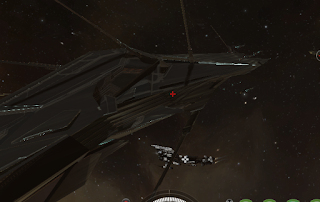I didn't really intend for this to become a three part series, but out of looking at this paper some advice for pirates, or Faction Warfare militias popped into my head.
The goal of this advice is to reduce the cognitive load on people trying to enter PvP. By reducing that particular barrier, you will see a rise in the number of people fighting in your particular systems.
Stock the station market.
One of the biggest issues facing new PvPers, in particular for solo PvP, is the logistical problem of getting ship to combat zone.
My very first foray into Faction Warfare involved fitting up a frigate from my base station, and then making a 30 jump journey to the warzone. Upon entering, I had 2 minutes of delightful combat against a Rupture, and then blew up. I got him down to structure though, and drunk on this perceived success, I eagerly warped back to my base to re-ship.
I got about halfway before I realised I'd need to get all the modules for the ship again. And in my home base, that meant a trip to Rens to get everything. Transport it back to my base to fit up the ship. Then 30 jumps again to find a Rupture, most likely long gone.
In short, a lot of thinking to get back into the fight.
My next PvP encounter would be years later, when I assumed the title Khanid Kataphract, and really applied my brain to getting into PvP.
Anecdotal evidence, but it's my experience.
Just think what could have happened if all the things I needed were right there in that very system. I could have re-fit instantly, maybe gotten a second try at that Rupture, and maybe even my first kill mail.
Stock the local stations with goods. Allow newbies to simply bring ISK with them, and not an indy with everything they think they need. Not only does it reduce the starting costs of PvP down, but it means they can change their fits without wasting ISK.
For FW neutral markets can be a massive boost. Militias can be locked out of stations, meaning that assets can be locked away. Great for denying space from the enemy, but the problem there is you've denied space to your enemy. Why are you in Faction Warfare if not to PvP? Why then take actions that actually restrict targets from coming to you?
If you work very hard, and find your home base far from the front lines, you've basically turned your PvP arena into a deserted back water. It takes even more thought power to reach you, so why even bother?
If you want to have more PvP, make it easy for PvP to take place in your system. Stock the markets. Don't camp the jump gates. Don't mock in Local. Make your space somewhere people actually want to come to.
Reduce the effort it takes to get there, and people will come.
The goal of this advice is to reduce the cognitive load on people trying to enter PvP. By reducing that particular barrier, you will see a rise in the number of people fighting in your particular systems.
Getting new players in system
Stock the station market.
One of the biggest issues facing new PvPers, in particular for solo PvP, is the logistical problem of getting ship to combat zone.
My very first foray into Faction Warfare involved fitting up a frigate from my base station, and then making a 30 jump journey to the warzone. Upon entering, I had 2 minutes of delightful combat against a Rupture, and then blew up. I got him down to structure though, and drunk on this perceived success, I eagerly warped back to my base to re-ship.
I got about halfway before I realised I'd need to get all the modules for the ship again. And in my home base, that meant a trip to Rens to get everything. Transport it back to my base to fit up the ship. Then 30 jumps again to find a Rupture, most likely long gone.
In short, a lot of thinking to get back into the fight.
My next PvP encounter would be years later, when I assumed the title Khanid Kataphract, and really applied my brain to getting into PvP.
Anecdotal evidence, but it's my experience.
Just think what could have happened if all the things I needed were right there in that very system. I could have re-fit instantly, maybe gotten a second try at that Rupture, and maybe even my first kill mail.
Stock the local stations with goods. Allow newbies to simply bring ISK with them, and not an indy with everything they think they need. Not only does it reduce the starting costs of PvP down, but it means they can change their fits without wasting ISK.
For FW neutral markets can be a massive boost. Militias can be locked out of stations, meaning that assets can be locked away. Great for denying space from the enemy, but the problem there is you've denied space to your enemy. Why are you in Faction Warfare if not to PvP? Why then take actions that actually restrict targets from coming to you?
If you work very hard, and find your home base far from the front lines, you've basically turned your PvP arena into a deserted back water. It takes even more thought power to reach you, so why even bother?
If you want to have more PvP, make it easy for PvP to take place in your system. Stock the markets. Don't camp the jump gates. Don't mock in Local. Make your space somewhere people actually want to come to.
Reduce the effort it takes to get there, and people will come.
























